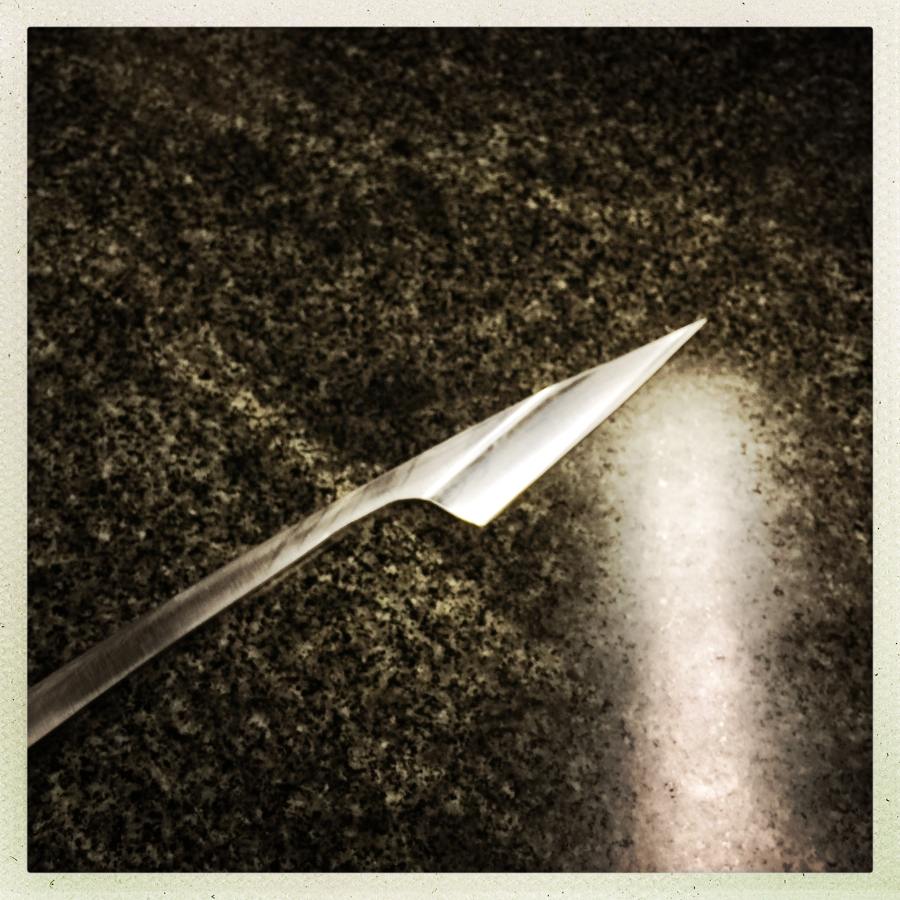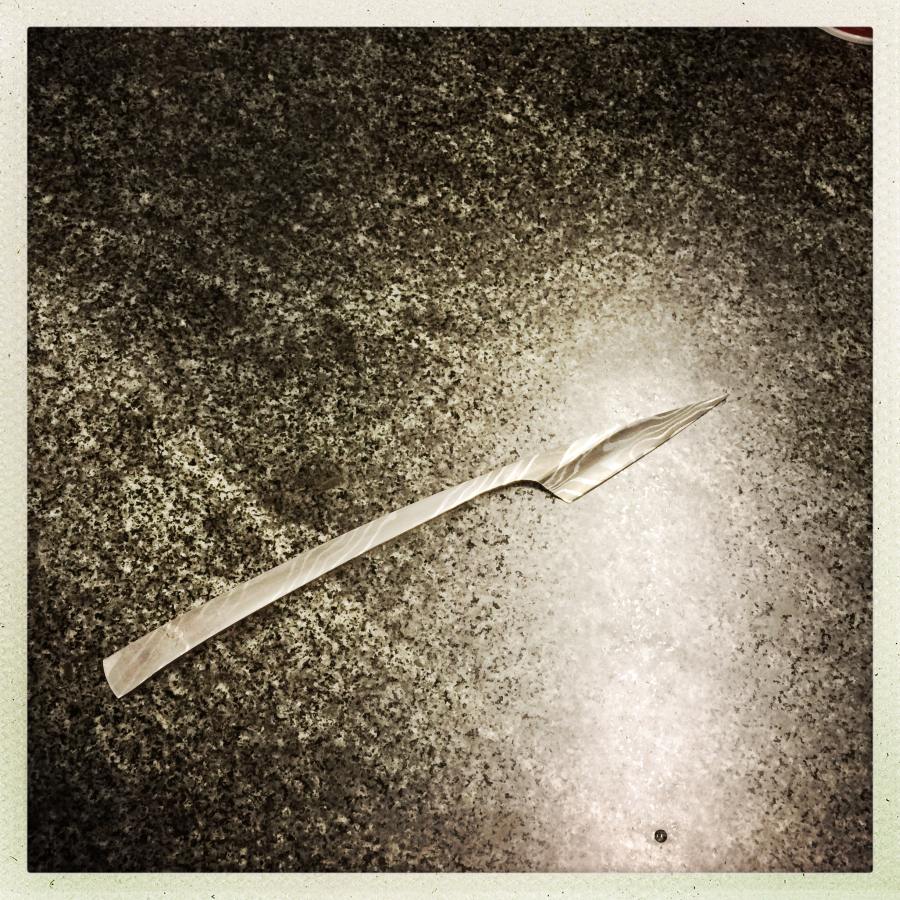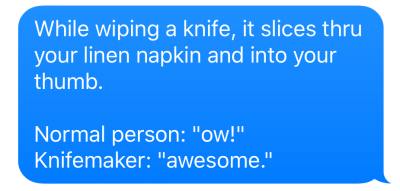Jazzlet’s knife is done.
I’m a bit concerned that bread dough is going to be hard to cut, even with something razor sharp. All that gluten that makes bread so crispy: it’s tough stuff. We shall see. Or, as they say “not my problem.”
After getting the rough shape right, it was merely a matter of grinding down one edge until it was very thin. I haven’t done a radical hollow-grind since I was in high school and I thought that something asymmetrical might help, I don’t know, push aside the now-severed gas-filled dough – kind of like a miniature plow blade tilling some field. Once I had that mental picture, I had to do it.

To get the grind I used the top idler wheel on my belt sander: just hold it steady and move it side to side. It sounds easy but it’s really not. The thinner the steel gets the faster it heats up under friction, and you can burn the metal of the tip in an instant if you forget to keep it wet. If it binds on the belt, it flings that little edge right at you with considerable speed. If you drop it, you can break the tip off. There is a lot that can go wrong.
Everything went right.
The photo above is not great. There’s not much for the camera to focus on and sometimes it hunts around – in this case it focused on my surface plate not the knife. [I will eventually write about my surface plates; they are one of my favorite things in the world right now] Anyhow, it’s hard to capture the curvature because from most angles it appears fairly flat. The knife only looks sharp when it’s moving, if that makes any sense.
Once it’s sharpened reasonably well, it’s time for a final etch and some brasso and wax to keep it from rusting too quickly. Over time the knife will change color as it’s used.

Because of the thin neck and the curve of the handle, it was kind of hard to sharpen by hand; the knife wanted to rotate in my fingers and that would have resulted in a wrong edge geometry. Fortunately, I was able to set up the final shape of the edge using my surface plate and some 1000-grit paper and oil.

‘comment made to Mike’ (self-portrait, 2018)
In the process of wiping the oil off the blade, the edge went right through the lintless cloth I was using and removed some of the fingerprints from my right thumb.
With etched damascus blades like these, you want them to look as nice as possible when they go to their new home. That means doing a lot of fiddly back and forth between a diamond sharpening stone, fine stones, and a tray with some ferric chloride and vinegar. You want the edge shiny but only just a line, so the user can see it and know what to avoid. What, don’t you have a bottle of ferric chloride in your kitchen?
“Will it score bread?”, that is the question.

Linen is also tough fiber stuff. If it goes through dough like it goes through cloth, it should do something like the trick.

ooh, that is very pretty
IME, bread dough is pretty easy to cut with a sharp knife and a slicing motion, so that should work beautifully.
Also, i know that feeling of slicing yourself through a cloth. i currently have a bandaid on my hand where i did it with one of my kitchen knives :P
I too have done the slicing though cloth into my thumb, though I was dumb enough to do it on heavy duty shirt tail, so I sliced a slit in an otherwise perfectly good shirt as well as the thumb.
I shall be very careful with my new knife. I think the plow blade idea ought to work well, the dough closing up behind the blade can definitely be a problem with a soft dough. Can’t wait to try it out.
So pretty!
:)
When wiping a blade, you wrap the cloth around it from the spine, with the edge facing away from your hand, and you wipe towards the edge, not away from it.
I shave with a straight razor. It does not permit careless handling.
Speaking of straight razors, you’ve actually come pretty close to making a kamisori here, Marcus…
Dunc@#5:
I have not tried a straight razor because, uh, no test subjects. (Eyes your throat narrowly) do you feel lucky?
ZOMG it’s beautiful!
Removed your fingerprint on your thumb? Nice… now you could commit a crime, and they will not be able to get a fingerprint from the crime scene! Unless of course you’re still there, bleeding. Never mind.
kestrel@#7:
Removed your fingerprint on your thumb? Nice… now you could commit a crime, and they will not be able to get a fingerprint from the crime scene! Unless of course you’re still there, bleeding. Never mind.
“Oh look at all these convenient splots of DNA the suspect left all over things.”
Very shiny!
I almost cut off the first cm of my thumb as a kid. I do have a very unique fingerprint there…
I know, all fingerprints are unique, but mine is visibly so.
Is that the final product we are looking at, or does it get some kind of handle?
Beautiful. You are indeed a craftsman.
Grinding tool steel and carbide bits for lathes we used the old eyeball the angles and dip cooling method but it took a lot of time and results were uneven. I was middling at best. Things went much faster when we installed a compressed air mist cooling system and learned how to set it up so it didn’t interfere with the operation. It took a few shocks, and at least one grinder motor before we got it set up right.
I lent by limited expertise with grounding, enclosed motors, and GFIs after a senior machinist was found semi-conscious. He was fine after a day of not being able to feel his hand. Tough old coot. Refused medical treatment and went back to work. Seemed most upset that his cigar, the one burnt down to a nub, went out.
The mist cooling system we used back in the 80s had a small control block with a couple of valves, a braided stainless line and a head about the size and shape of a pen where compressed air blew cross-ways over a little brass tit . This cause the Venturi effect to suck up a thin mix of water and rust preventative. The control valves moderated the compressed air and coolant flow. The mix of air cooled by decompression and water really sucks up the heat. On coolish days our hands would freeze.
The big advantage of this sort of system is that you can focus on positioning the piece against the wheel once, as perfectly as possible, and then grind for a long time without worrying about overheating even on very thin sections. With dipping to cool the piece you have to juggle precision placement on the wheel, time grinding, and heat. Every time you have to recreate the geometry is an opportunity for error with the stakes getting higher every cycle as you get closer to finishing. A single slip or moment of inattention can undo hours of hard work.
Reginald Selkirk@#10:
Is that the final product we are looking at, or does it get some kind of handle?
It’s got a handle! It’s just a one-piece steel instrument.
I actually did think about putting slabs on the side but it seemed like a shame to cover up the pattern just for the dubious pleasure of shaping some wood.
This is predicated on the user not heating it up to high temperatures long enough for the heat to migrate down the handle.
It’s going to be used on bread dough at little over room temperature, it will likely get covered in flour and dough so being easy to wash is important, the handle it has is perfect.
The one time we were burgled, when we were away for the weekend with our first GSD, the idiot broke a window to get in; in doing so he left a perfect full had print on a piece of glass, and also a cotton swab he’d used to staunch the blood from a cut he’d got in the process. About two months later the police phoned us up very pleased as they’d caught him burgling a church, and there he was on the system for our burglary, it meant he got put away for longer as domestic burglaries carry a higher tarrif than commercial burglary they were extremely pleased. Turned out he was a drug addict from Liverpool ‘working’ in Sheffield as he was too well known at home, we were burgled by a cliche.
I’ve got a surface plate, too. They’re pretty neat. I’ve thought about using it for sharpening, but I’m paranoid about getting abrasives onto the plate itself and getting it out of flat.
I’ve never carved a fingerprint off of myself, but I do have a fingerprint with a line in it where the ridges on each side don’t line up properly.
That is incredibly lovely.
Your story reminds me a drunken college night that started with a dull serrated knife and a stick of pepperoni and ended with bloody thumbs and many band-aids.